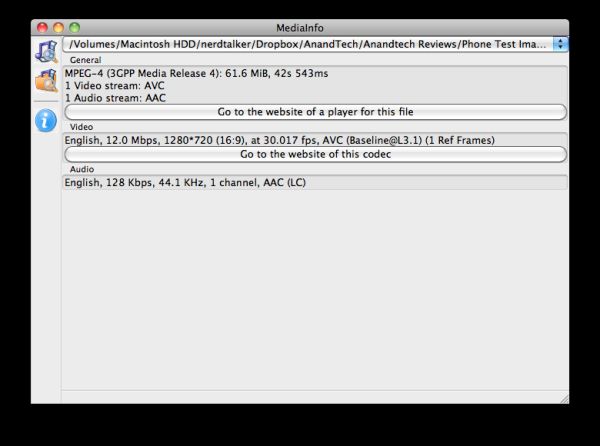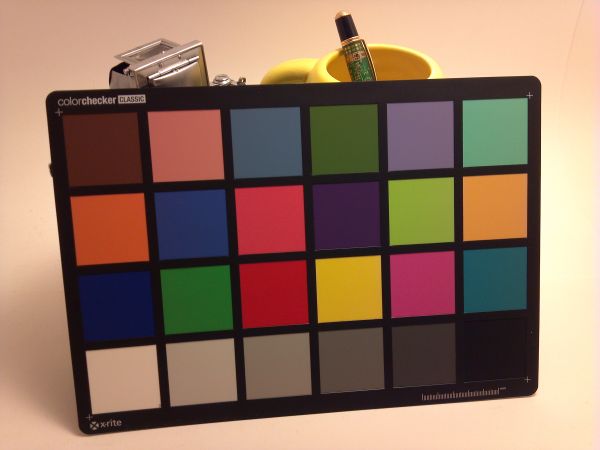Motorola Droid X2 Review - A Droid X with Tegra 2
by Brian Klug on July 7, 2011 8:31 AM ESTCamera - Upgraded
Captured image quality is getting better with time, thanks to both improved image signal processing (ISP), software, optics, and of course sensors. Thankfully the X2 brings the entire package of improvements to the table. First off, the most obvious difference is that the mechanical shutter is gone (whose purpose I never quite understood), and the first vertex of the camera seems to have a larger diameter, meaning it has improved light collection over the X.
The original X was one of the first smartphones we tested with 720p video capture after the iPhone 4 made its debut. At that time, the X captured 720p24 8 Mbps MPEG-4 video with 1 channel 96 Kbps AAC audio. The X2 bumps video capture up to 720p30 H.264 at 12 Mbps with 128 Kbps single channel AAC audio.
Obviously the Tegra 2 SoC inside the Droid X2 could capture at 1080p, but we’d honestly rather see high quality 720p like the X2 shoots over lower bitrate 1080p. Honestly, 1080p still remains a checkbox feature today until bitrates get higher or encoders get better.
I initially noticed a serious problem with video capture on the X2. Set to capture to the external SD card (by default), video had second long dropouts and stalls, like this. Around 12 and 19 seconds, the fun starts:
On the device itself, capture would correspondingly pause, hang, and even crashed once. I shot two or three videos to confirm to myself that it wasn’t just a fluke, and also closed every application to see if RAM consumption was a problem. After some googling and discovering similar complaints on forums, I stumbled on the problem - set the capture destination to internal storage, and the stuttering goes away. I went and re-captured the video, and boom, no stuttering:
What’s curious about the whole thing is that the card shouldn’t be the problem. I tested the 8 GB class 4 microSD card inside the X2 (which comes preinstalled) in a new USB 3.0 Lexar card reader with CrystalDiskMark and found that it had sequential writes of just over 5 MB/s. Far more than the 1.5 MB/s which would be required for the X2’s 720p video + audio stream. Testing with a 32 GB class 2 resulted in no stuttering, and after a format the supplied microSD card went back to not stuttering. Either way, if you experience problems, switch to internal storage, format the external, or get another microSD card.
The X2 includes an 8 MP camera with dual LED flash, just like the previous X. However, there’s more to image quality than just MP numbers, which would have you thinking that everything is the same.
Still image quality on the X2 is improved from the original Droid X. In some ways it’s considerably better, others the same.
White balance in our lighbox test is a bit warm, as are a few outdoors test shots. There’s some chromatic aberration at the extreme angles in the lightbox test as well, evidenced by the red circle around the image. That said overall sharpness seems better.
What I miss from the Droid X is that camera button, which (as I mention in the video review) Motorola seriously emphasized the first time around as a distinguishing feature for the X. The problem isn't so much that it's gone as it is that the camera software now relies on an awkwardly placed software capture button. What I mean is that the X2 uses the exact same camera UI as the original X, which obviously was tailored around using the shutter button instead of the software shutter button. As a result, more often than not I would press near (but not on) the button and just toggle the OSD instead of taking a photo.






































72 Comments
View All Comments
HangFire - Thursday, July 7, 2011 - link
When are you going to review the Charge? Now, there's a screen!HangFire - Thursday, July 7, 2011 - link
Oops I see it has been reviewed, but it is missing in the third comparison graph- Contrast- on page 2.HangFire - Thursday, July 7, 2011 - link
Page 5? I'm sorry I'm used to MODERN comments section with at least a 60 second edit feature.Brian Klug - Thursday, July 7, 2011 - link
It isn't missing, it simply isn't included. The effective contrast of the SAMOLED+ panels is undefined (divide by zero).-Brian
Vepsa - Thursday, July 7, 2011 - link
What app do you show in the GPS testing screenshots?Brian Klug - Thursday, July 7, 2011 - link
I like to use GPS Test Plus, it does a decent job.-Brian
cditty - Thursday, July 7, 2011 - link
No reason to upgrade... I bought my Droid X for .01 from Amazon when I rid myself of the craptastic AT&T in my market.It is the best phone I ever had (I was an iPhone 4 user on AT&T). Verizon's network is what makes me say that, because ALL of the phone works ALL of the time (calls & data).
The original X is plenty fast. My next upgrade will be when my market goes LTE (a long way off). By then, there will be some great phones to be excited about. Funny how phones are the new *upgrade* hobby for old school computer enthusiast.
silow675 - Thursday, July 7, 2011 - link
Brian I think you have the best mobile handset reviews. Great work on including thorough reviews on mobile displays - something lacking in most mobile reviews.Spoelie - Thursday, July 7, 2011 - link
That thing looks hideous compared to recent HTC ventures, like some 80's throwback.Mind you, I'm not talking about performance or usability or screen quality or ... It's purely my own opinion on physical styling of the device.
jonup - Thursday, July 7, 2011 - link
Well, we spent the 90s and the better part of the last decade making phones smaller and more portable... and then all the effort went down the drain.You can thank Apple for that. After the iphone everyone try better them with bigger and heavier phone. Remember, in America bigger is better!